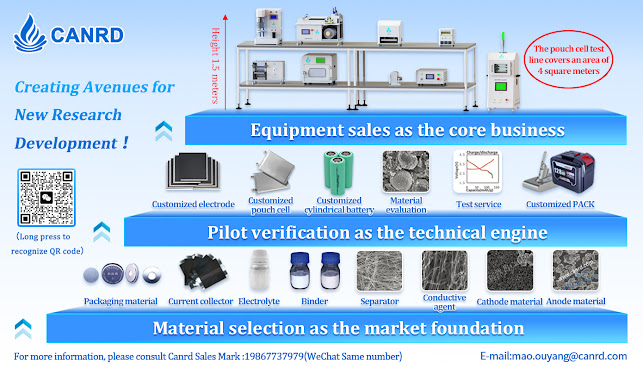1.Battery structure
1.1.Commonly used battery structures
Pouch battery Aluminum shell battery Cylindrical batteries Coin cell
1.2.Internal structure - Pouch battery
1.2.1.Winding structure
1.2.2.Laminated structure
2.Cell size
2.1.Pouch battery model:425868
3.Design principles
3.1.Electrode Size
3.1.1.Margin of Width:
Negative electrode width-positive electrode width≥1.5mm(C1+C2)
Separator width - negative electrode width≥1.5mm(S1+S2)
3.1.2.Length Surplus:
Negative Electrode Length-Positive Electrode Length≥2.0mm(A1+A2)
Separator width - negative electrode width≥5.0mm(B1+B2)
3.2.N/P ratio
3.2.1.N/P =anode reversible capacity/cathode reversible capacity
3.2.2.=Negative electrode delithium capacity (charging during deduction) / Positive electrode lithium intercalation capacity (discharging during deduction)
3.2.3.1st C.E.=Reversible Capacity / (Reversible + Irreversible) Capacity
3.2.4. =De-lithiation Capacity of the Negative Electrode / Lithiation Capacity of the Negative Electrode
3.2.5. =Lithiation Capacity of the Positive Electrode / De-lithiation Capacity of the Positive Electrode
3.2.6.The negative electrode lithium intercalation capacity/positive electrode lithium delithium capacity is more practical, and only >1 can theoretically ensure that there is no problem of lithium separation
3.2.7.Therefore, conventional lithium cobalt oxide and lithium iron can match the N/P value of graphite material 1.08~1.12
3.2.8.The N/P value of ternary materials with low initial efficiency matching graphite materials needs to be increased to 1.15~1.20, because (the first effect of the positive electrode/the first effective value of the negative electrode) is obviously low
3.2.9.The N/P value of conventional lithium cobalt oxide and lithium iron matched silicon carbon 550 can be reduced by 1.06 because the first efficiency of silicon carbon 550 is low
3.3.Charge-discharge interva
3.3.1.Design principles of charge and discharge voltage range:
3.3.2.(1) The charge and discharge capacity should be accurate (convenient to
accurately calculate the capacity of the positive and negative electrodes by
coating weight)
3.3.3.(2) Within the charging and discharging voltage window, the positive and negative
electrode capacities are basically exerted
3.3.4.The capacity of the positive electrode 3.0~3.6V interval and the negative electrode
0.6~1.5V interval is very small
3.3.5.(3) Whole cell voltage = positive potential - negative potential
3.3.6.The positive electrode is 3.0~4.45V, the negative electrode is 0.005~1.5V
3.3.7.Therefore, the conventional lithium cobalt oxide capacity is set at 3.0~4.45V
(3.0=3.6-0.6)
3.4.Three-electrode test
3.5.Coating weight
3.5.1.Coating range: 7mg/cm2< cathode coating weight<25mg/cm2 (ternary, lithium
cobalt oxide empirical value)
3.5.2.If the coating surface density is too low, the equipment has limitations and coating
leakage may occur. If the surface density is too high (commonly known as thick coating),
the kinetic performance will be deteriorated, leading to poorer battery performance
(such as cycle life, rate capability, etc.).
3.6.Tabs
3.6.1.Tab design principles:
3.6.2.Capacity<1Ah, tab size 2mm*0.08mm (width * thickness)
3.6.3.1Ah< capacity <3Ah, tab size 4mm*0.08mm
3.6.4.3Ah< capacity <5Ah, tab size 6mm*0.1mm
3.6.5.5Ah< capacity <8Ah, tab size 6mm*0.15mm
3.6.6.Capacity>8Ah, tab size widened, thickness 0.2mm
3.7.Others
3.7.1.Other materials, such as foil, aluminum-plastic film and separator, etc., are
selected according to the application, if only an experiment, recommended foil
material:
copper foil ≥ 8um, aluminum foil ≥ 14um, aluminum-plastic film: ≥113um, separator≥
12um.
3.7.2.If it is a high energy density requirement, a thinner one can be considered, but
this material requires high process capacity, otherwise will sacrificed the yield.
Foil material Aluminum-plastic film Separator
4.Canrd Brief Introduce
Canrd use high battery R&D technology(core members are from CATL) and strong Chinese supply chain to help many foreign companies with fast R&D. We provide lab materials, electrodes, custom dry cells, material evaluation, perfomance and test, coin/pouch/cylindrical cell equipment line, and other R&D services.
Email: contact@canrd.com Phone/Wechat/WhatsApp: +86 19867737979
Canrd Official Web Canrd Company Vedio Canrd Company profile
Website : www.canrud.com








No comments:
Post a Comment